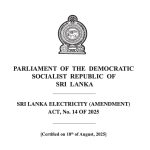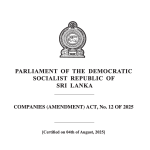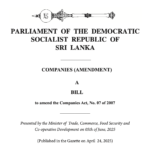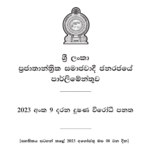Case Title: Tissa Nagodawithana Films (Pvt) Ltd. v. Hemapriya Kandamby & Independent Television Network Ltd.
Case Number: CHC/25/2014/IP
Court: High Court of the Western Province, Colombo (Civil/Commercial Jurisdiction)
Judgment Date: October 8, 2024
Introduction
This case concerns a dispute over the telecasting rights for two Sinhala films, “Nohadan Amme” (referred to as “Samawenna Ma Raththarane” in the proceedings) and “Thakkita Tharikita.” The Plaintiff, Tissa Nagodawithana Films (Pvt) Ltd., alleged infringement of their intellectual property rights and sought declaratory reliefs, damages, and injunctive orders. The 1st Defendant, Hemapriya Kandamby, counterclaimed for ownership of the telecasting rights and sought damages and injunctive relief.
Parties Involved
- Plaintiff: Tissa Nagodawithana Films (Pvt) Ltd.
- 1st Defendant: Hemapriya Kandamby
- 2nd Defendant: Independent Television Network Ltd. (ITN)
Reliefs Sought
The Plaintiff sought:
- Declarations affirming their ownership of telecasting rights for the films.
- Damages of Rs. 1,000,000 and Rs. 2,000,000 for infringement.
- Permanent injunctions against further unauthorized telecasting.
The 1st Defendant sought:
- Declarations affirming their ownership of telecasting rights.
- Damages of Rs. 5,000,000.
- Injunctions against the Plaintiff.
Key Issues
1. Ownership of Telecasting Rights
The central issue was determining who held the telecasting rights for the two films:
- “Nohadan Amme”/”Samawenna Ma Raththarane”
- “Thakkita Tharikita”
2. Validity of Agreements
The authenticity of the agreements presented by both parties was questioned, including allegations of forgery and non-compliance with statutory requirements.
3. Infringement of Intellectual Property Rights
Both parties alleged that the other had infringed their respective telecasting rights.
4. Damages and Reliefs
The court examined claims for damages and requests for injunctive reliefs based on the alleged infringements.
Findings
Film 1: “Nohadan Amme”/”Samawenna Ma Raththarane”
- Documentary Evidence:
- The Plaintiff relied on an agreement (P4) dated April 10, 2002, purportedly transferring telecasting rights to their predecessor.
- The 1st Defendant relied on a later agreement (1V6) dated August 10, 2005, transferring rights from the producer, Mr. Kandapola Kumaratunga.
- Authenticity of Agreements:
- The court noted discrepancies in P4, including the absence of evidence that a film titled “Nohadan Amme” was ever publicly screened under that name.
- The film was first released as “Samawenna Ma Raththarane” in 2004, two years after the date of P4.
- The court found 1V6 credible and substantiated by supporting evidence.
- Ownership:
- The court ruled that the 1st Defendant lawfully held the telecasting rights, as established by 1V6.
Film 2: “Thakkita Tharikita”
- Plaintiff’s Claim:
- The Plaintiff presented a chain of transactions starting from the alleged widow of the producer, Mary Francis Wass, transferring rights to Victor Manage and then to the Plaintiff.
- 1st Defendant’s Claim:
- The 1st Defendant claimed rights inherited from the producer, Hubert Anthony, via his son and estate administrator, Konganige Christoper Angelo Pradeep Anthony.
- Evidence Considered:
- Documents 1V1 and 1V2 (publications by the National Film Corporation) identified Hubert Anthony as the producer.
- The Plaintiff’s chain of ownership was deemed unsubstantiated due to the lack of proof of Mary Francis Wass’ legal status as heir.
- Ownership:
- The court upheld the 1st Defendant’s claim, citing valid transfers from the legal heirs of Hubert Anthony.
Infringement Allegations
The Plaintiff’s allegations of infringement by the 1st Defendant were dismissed. Conversely, the Plaintiff was found to have infringed the 1st Defendant’s rights by telecasting “Samawenna Ma Raththarane” without authorization.
Damages
The Plaintiff’s claims for damages were rejected. The court awarded no damages to the 1st Defendant but confirmed their ownership rights.
Legal Analysis
1. Intellectual Property Act No. 36 of 2003
The court relied on key provisions:
- Section 6: Protection of audiovisual works.
- Section 9: Exclusive rights of copyright owners.
- Section 16: Requirements for the transfer of economic rights.
2. Precedent
- Ramesh Sippy v. Shaan Ranjeet Uttamsingh & Ors.: The producer, as the financial contributor, is considered the author and copyright owner unless otherwise agreed.
3. Validity of Agreements
The court found that:
- Agreements P4 (Plaintiff) and 1V6 (Defendant) met statutory requirements under Section 16 of the Intellectual Property Act.
- Allegations of forgery were not substantiated.
Conclusion
The High Court ruled in favor of the 1st Defendant, affirming their ownership of the telecasting rights for both films. The Plaintiff’s claims were dismissed, and the court found no infringement by the 1st Defendant.
Recommendations
For stakeholders in the film and entertainment industry:
- Ensure clear, documented ownership and transfer of intellectual property rights.
- Verify the authenticity of agreements and compliance with statutory requirements.
- Maintain a robust chain of title documentation to avoid disputes.














